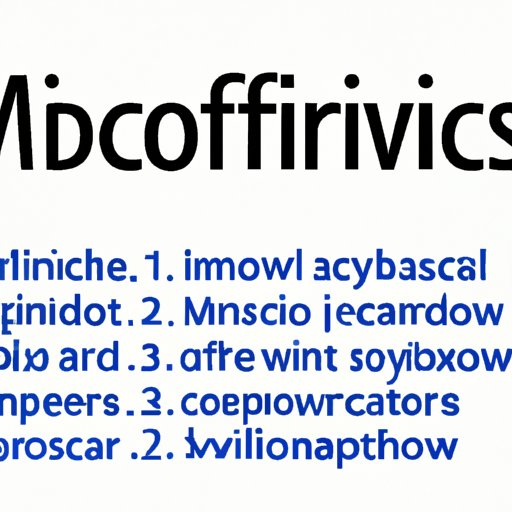Creating a Table of Contents in Word: A Step-by-Step Guide
Microsoft Word is one of the most widely used word processors available, capable of producing high-quality, professional-level documents. However, many users find themselves struggling to create table of contents in Word. Unsurprisingly, creating and formatting a table of contents can seem a bit overwhelming at first. Fortunately, with some knowledge and practice, it’s easier than you might think. In this article, we’ll take a look at various techniques and tools that can help you to create and customize your own table of contents in Word.
A Step-by-Step Guide
Before beginning this tutorial, make sure you have a Word document in which you wish to create a table of contents. Once you have your document ready, follow the steps below:
Step 1: Marking the Headings
In order for Word to generate a table of contents, headings (also known as sections) must be marked. First, select the text or headings that identify the sections you want to include in the table. Highlight your headings, right-click, and select “Styles.” From here, choose from the four predefined heading styles:
- Heading 1
- Heading 2
- Heading 3
- Heading 4
Alternatively, you can create your own Heading style following the steps that we will discuss later. It’s important to use these styles, as Word will recognize them and create the table of contents accordingly.
Step 2: Creating the Table
Once you mark the headings, creating the table of contents is incredibly easy. Move your cursor to where you’d like the table to appear in your document and click on “References” on the menu bar. From here, click Table of Contents, and then select the style of the table you want to use.
Voilà! Word created a table of contents for you. Of course, this table is not visually organized yet and is subject to change as you make adjustments.
Step 3: Adjusting the Table of Contents
With the table created, you can now adjust it to meet your needs. There are a few methods for doing this:
- From the menu bar, click “Table of Contents” and select “Custom Table of Contents.” From there, you can adjust your table according to your preferences, including changing the font size, the number of levels displayed, and more.
- While on the “Table of Contents” page, right-click and choose “Update Field” to update the table dynamically to match the changes you’ve made in your document
Step 4: Customizing Your Table
Finally, you can further customize your table by modifying the styles governing it and its contents. This includes elements such as font, color scheme, and other formatting rules.
Video Tutorial
As you’ve seen, creating a table of contents in Word is a simple process. However, if you prefer to learn visually, there are plenty of resources out there. One video tutorial that may be of interest is this:
This video will guide you through the entire process of creating a table of contents in Word, with helpful tips and tricks along the way.
For more in-depth learning, check out the resources below:
- Microsoft’s Support Page for Creating Table of Contents in Word
- Creating a Table of Contents with Word 2016 by GCFLearnFree.org
Quick Tips
If you’re in a hurry and would rather skim through the process quickly, here are some quick and easy steps to creating a table of contents in Word:
- Identify the headings you want as part of your table of contents and format them with styles such as Heading 1, 2, or 3
- Place your cursor where you would like the table of contents to appear
- Click the “References” tab in your menu bar
- Select “Table of Contents”
- Choose the visual style of your table
And voila – you’ve created a table of contents in Word!
While this condensed list doesn’t offer up the same level of detail as our full step-by-step guide, it’s a great option to get started with the process quickly.
Expert Tips
Finally, we’ve geared some of our expert tips and tricks towards our readers who are already familiar with Word and are comfortable using the software.
Alternative Printing Option
Although much of this process takes place in Word, you can make changes to your table of contents through the print menu. Simply select “Update Table of Contents” from your print menu and make any adjustments that you need.
Advanced Customization
As we mentioned earlier, customizing your table of contents is essential for optimizing it. With a little experimentation, you can modify the style of the headings and the table itself to meet your specific needs.
Comprehensive Tools
In Word, there are a variety of helpful tools you can use to make creating a table of contents even easier. Here, we’ll introduce you to some of those features:
Custom Heading Styles
Make sure when you apply heading to use the styles that come with the software. Alternatively, you can create your own style by clicking on “New Style” when you right-click “Styles” from the home tab of the tool ribbon. From here, you can modify fonts, colors, and other style elements.
Outline View
Word has an Outline view that is designed specifically to help you organize your content. Simply click “View” in the ribbon and then choose “Outline View.” From here, you can easily move headings around and even promote or demote them to different levels.
Conclusion
In conclusion, creating a table of contents in Word shouldn’t be daunting. With the help of the step-by-step guide, video tutorials, and expert tips, everyone can master this important document formatting skill. Whether you’re looking to create a sophisticated table of contents or just need to get one up and running quickly, the tools and features available in Microsoft Word make it easy. Remember to experiment with styles, fonts, and other formatting elements to make your table of contents truly unique.
